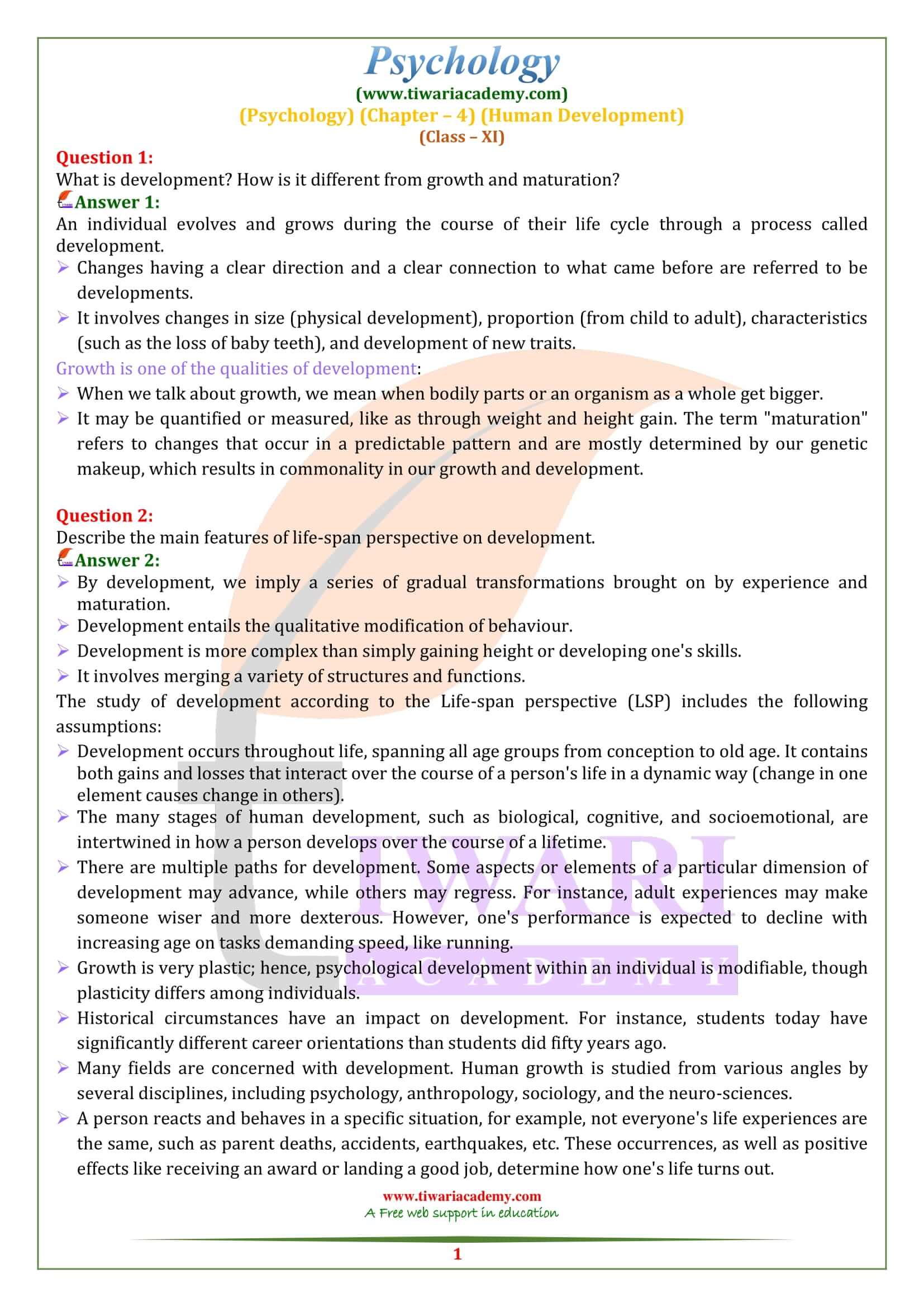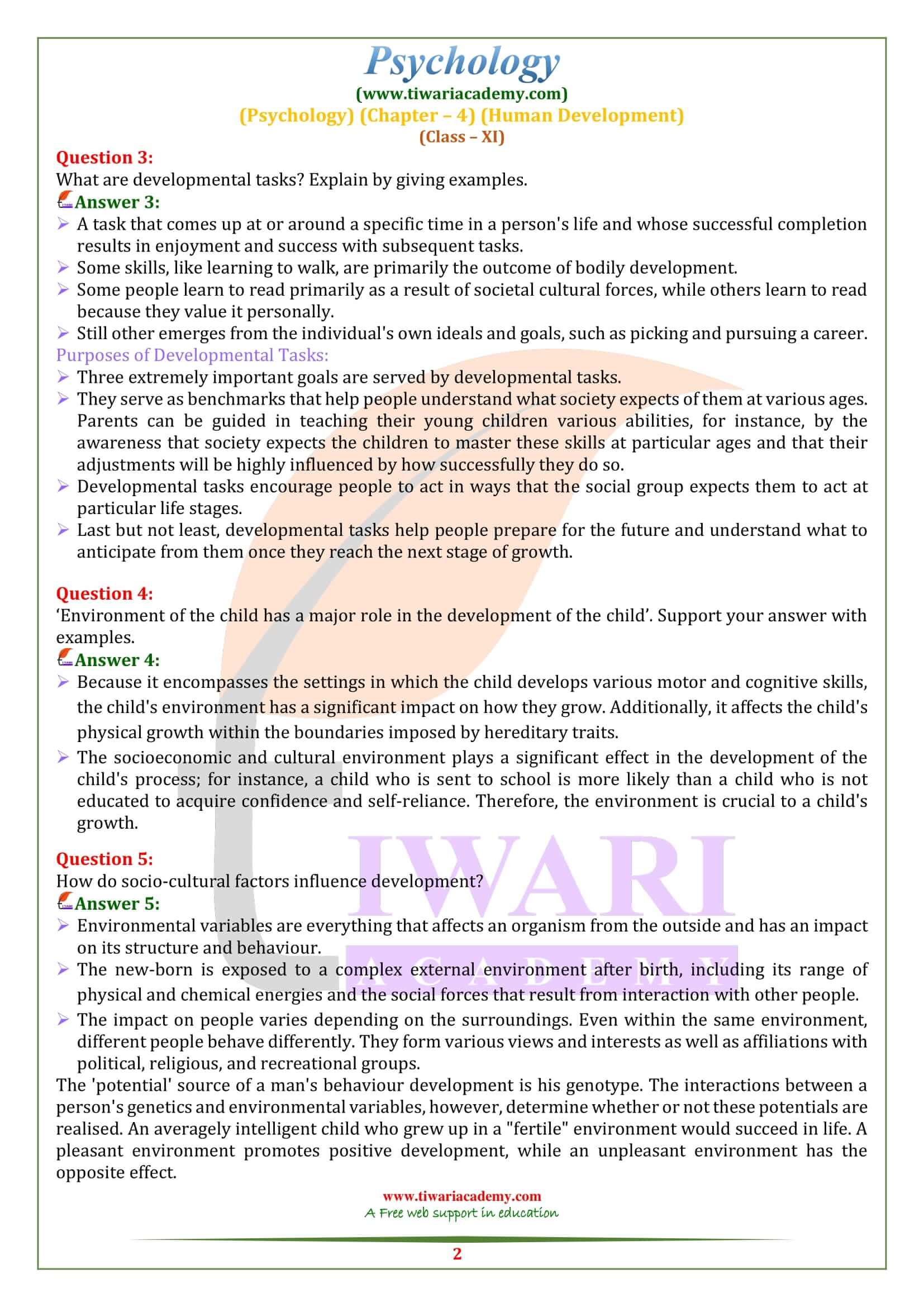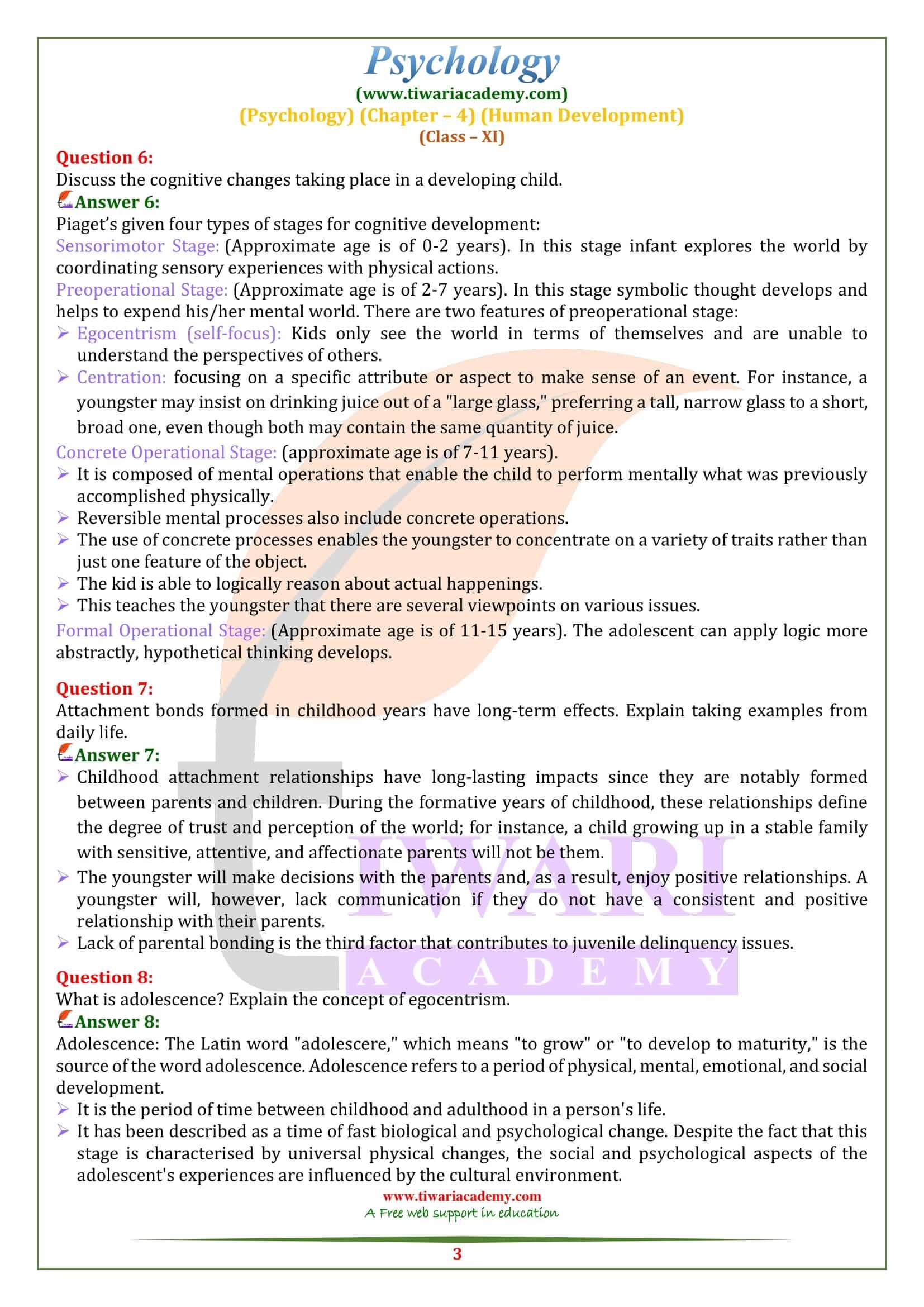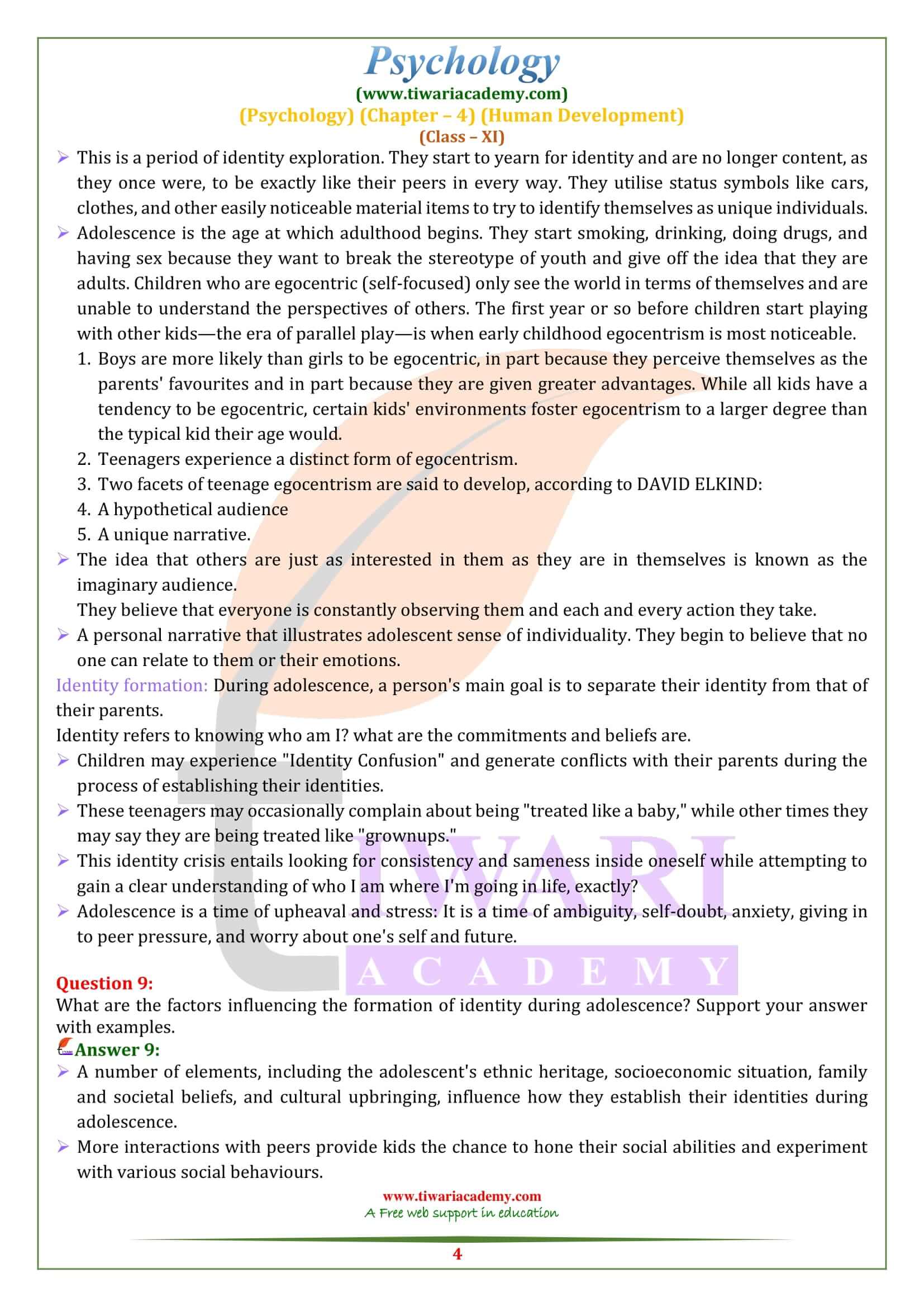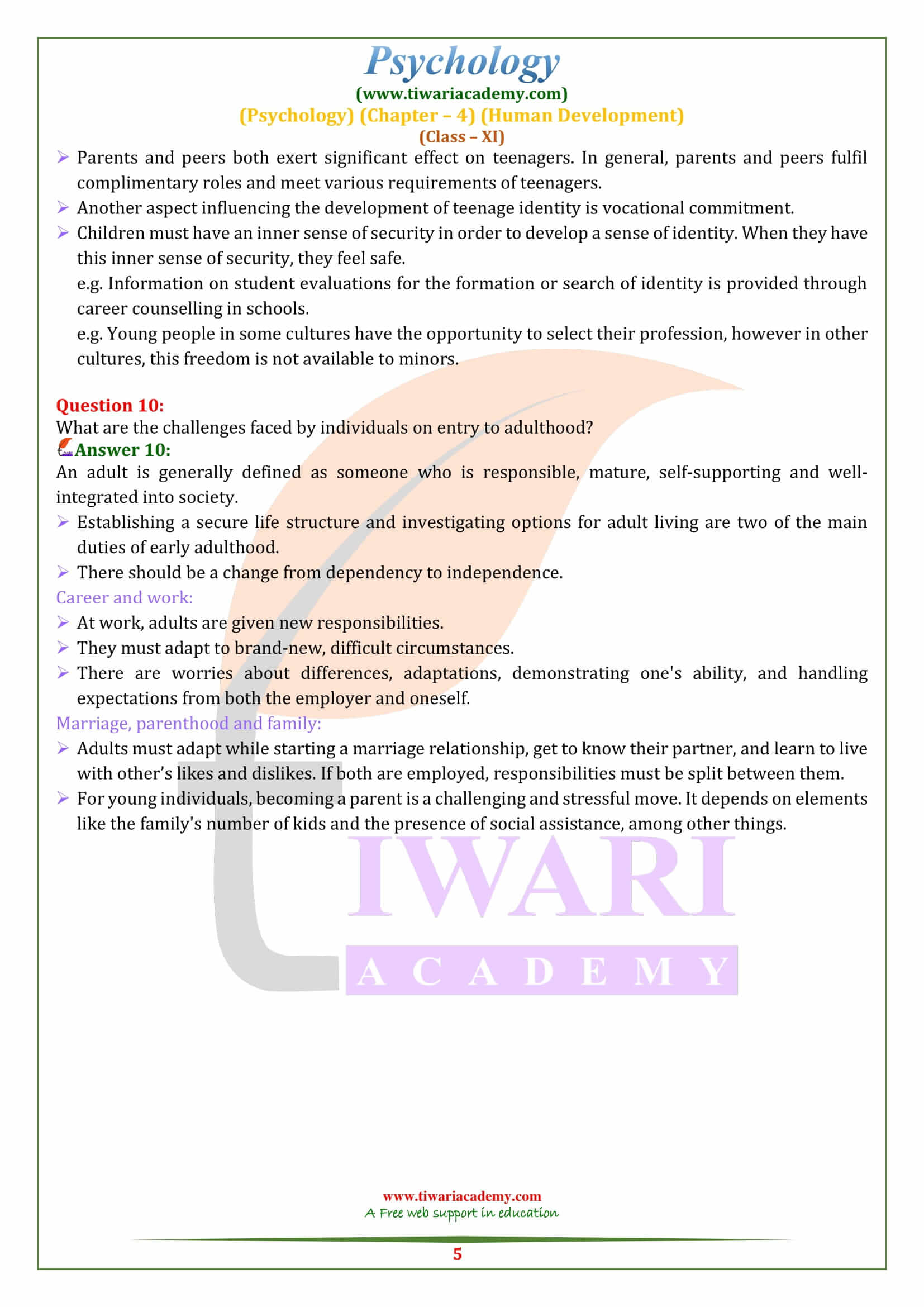NCERT Solutions for Class 11 Psychology Chapter 4 Human Development in English Medium modified for new academic session 2024-25. All the extra questions which are important for board exams are given here with MCQs to help the students in preparation of school exams.
NCERT Solutions for Class 11 Psychology Chapter 4
Class 11 Psychology Chapter 4 Human Development Question Answers
What is development? How is it different from growth and maturation?
An individual evolves and grows during the course of their life cycle through a process called development.
- Changes having a clear direction and a clear connection to what came before are referred to be developments.
- It involves changes in size (physical development), proportion (from child to adult), characteristics (such as the loss of baby teeth), and development of new traits.
Growth is one of the qualities of development: - When we talk about growth, we mean when bodily parts or an organism as a whole get bigger.
- It may be quantified or measured, like as through weight and height gain. The term “maturation” refers to changes that occur in a predictable pattern and are mostly determined by our genetic makeup, which results in commonality in our growth and development.
Describe the main features of life-span perspective on development.
- By development, we imply a series of gradual transformations brought on by experience and maturation.
- Development entails the qualitative modification of behaviour.
- Development is more complex than simply gaining height or developing one’s skills.
- It involves merging a variety of structures and functions.
The study of development according to the Life-span perspective (LSP) includes the following assumptions:
Development occurs throughout life, spanning all age groups from conception to old age. It contains both gains and losses that interact over the course of a person’s life in a dynamic way (change in one element causes change in others).
The many stages of human development, such as biological, cognitive, and socioemotional, are intertwined in how a person develops over the course of a lifetime.
There are multiple paths for development. Some aspects or elements of a particular dimension of development may advance, while others may regress. For instance, adult experiences may make someone wiser and more dexterous. However, one’s performance is expected to decline with increasing age on tasks demanding speed, like running.
Growth is very plastic; hence, psychological development within an individual is modifiable, though plasticity differs among individuals.
Historical circumstances have an impact on development. For instance, students today have significantly different career orientations than students did fifty years ago.
Many fields are concerned with development. Human growth is studied from various angles by several disciplines, including psychology, anthropology, sociology, and the neuro-science.
A person reacts and behaves in a specific situation, for example, not everyone’s life experiences are the same, such as parent deaths, accidents, earthquakes, etc. These occurrences, as well as positive effects like receiving an award or landing a good job, determine how one’s life turns out.
What are developmental tasks? Explain by giving examples.
- A task that comes up at or around a specific time in a person’s life and whose successful completion results in enjoyment and success with subsequent tasks.
- Some skills, like learning to walk, are primarily the outcome of bodily development.
- Some people learn to read primarily as a result of societal cultural forces, while others learn to read because they value it personally.
- Still other emerges from the individual’s own ideals and goals, such as picking and pursuing a career.
Purposes of Developmental Tasks:
- Three extremely important goals are served by developmental tasks.
- They serve as benchmarks that help people understand what society expects of them at various ages. Parents can be guided in teaching their young children various abilities, for instance, by the awareness that society expects the children to master these skills at particular ages and that their adjustments will be highly influenced by how successfully they do so.
- Developmental tasks encourage people to act in ways that the social group expects them to act at particular life stages.
- Last but not least, developmental tasks help people prepare for the future and understand what to anticipate from them once they reach the next stage of growth.
Environment of the child has a major role in the development of the child. Support your answer with examples.
Because it encompasses the settings in which the child develops various motor and cognitive skills, the child’s environment has a significant impact on how they grow. Additionally, it affects the child’s physical growth within the boundaries imposed by hereditary traits.
The socioeconomic and cultural environment plays a significant effect in the development of the child’s process; for instance, a child who is sent to school is more likely than a child who is not educated to acquire confidence and self-reliance. Therefore, the environment is crucial to a child’s growth.
How do socio-cultural factors influence development?
Environmental variables are everything that affects an organism from the outside and has an impact on its structure and behaviour.
The new-born is exposed to a complex external environment after birth, including its range of physical and chemical energies and the social forces that result from interaction with other people.
The impact on people varies depending on the surroundings. Even within the same environment, different people behave differently. They form various views and interests as well as affiliations with political, religious, and recreational groups.
The ‘potential’ source of a man’s behaviour development is his genotype. The interactions between a person’s genetics and environmental variables, however, determine whether or not these potentials are realised. An averagely intelligent child who grew up in a “fertile” environment would succeed in life. A pleasant environment promotes positive development, while an unpleasant environment has the opposite effect.
Attachment bonds formed in childhood years have long-term effects. Explain taking examples from daily life.
Childhood attachment relationships have long-lasting impacts since they are notably formed between parents and children. During the formative years of childhood, these relationships define the degree of trust and perception of the world; for instance, a child growing up in a stable family with sensitive, attentive, and affectionate parents will not be them.
The youngster will make decisions with the parents and, as a result, enjoy positive relationships. A youngster will, however, lack communication if they do not have a consistent and positive relationship with their parents.
Lack of parental bonding is the third factor that contributes to juvenile delinquency issues.
